
ESS has signed a Memorandum of Understanding with the Swedish Research Council, Vetenskapsrådet (VR), and the Swedish Innovation Agency, Vinnova, to further support and develop the strategic partnership between the parties.
The aim of the Memorandum of Understanding (MoU) is to realise the full potential of ESS as the world-leading, premier source for neutron scattering by supporting knowledge and competence building and scientific excellence in Sweden. This will allow Sweden to take full advantage of the unique possibilities that will be offered by the research facility under construction in Lund. The establishment of an international Big Science facility on Swedish soil strengthens Sweden’s position as a research and innovation nation.
“We look forward to an increased collaboration to develop ESS into a world-leading research infrastructure that Swedish research and innovation can make the most possible benefit from,” said VR Director General, Sven Stafström. “The expectations ahead of First Science at ESS are high, and it is important to prepare and join forces to be able to take advantage of the extraordinary resources that ESS will provide. Both VR and Vinnova have leading roles in such a mobilisation, which will result in scientific breakthroughs and innovations within a wide range of areas.”
ESS has 13 member countries, with Sweden and Denmark as host countries. As host, Sweden plays an important role in the realisation and coming operations of the research facility. The Swedish Research Council, Sweden’s main national funding body of research infrastructures, is since long deeply involved in ESS, and the innovation agency Vinnova has also been collaborating with ESS for several years. The recently signed MoU further enhances this cooperation between the parties. The aim is to increase Swedish academia’s and industry’s involvement in ESS and to develop the already existing collaborations within research and innovation.
“ESS will be essential in the development of new knowledge and innovations that can contribute in the transition to a sustainable society,” said Darja Isaksson, Vinnova Director General. “In a couple of years the facility will be ready for users, but already, work is ongoing to develop the technical solutions that will create opportunities for Swedish research and industry. Together with the Research Council we work to ensure that the large potential for Sweden, provided by ESS, will be harvested.”
This spring, the VR and Vinnova, on behalf of the Swedish government, launched a joint Office for coordination of national efforts towards ESS and MAX IV. The recently signed MoU is an another step and part of Sweden’s ESS strategy.
“This MoU helps to consolidate Sweden’s role as host for ESS and its position as a leading research nation,” said ESS Director General, John Womersley. “We look forward to working even more closely with the Swedish Research Council and Vinnova, and as ESS gets closer to delivering First Science this is an important step for Swedish research and industry.”
























